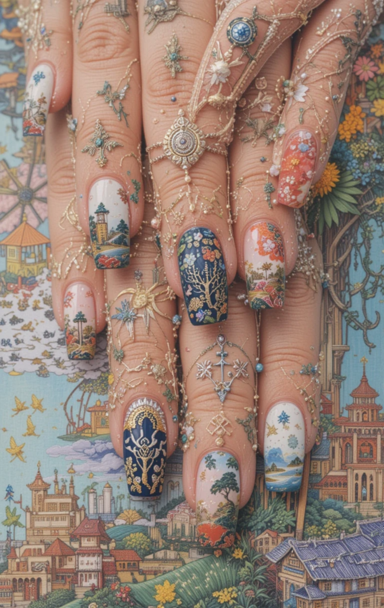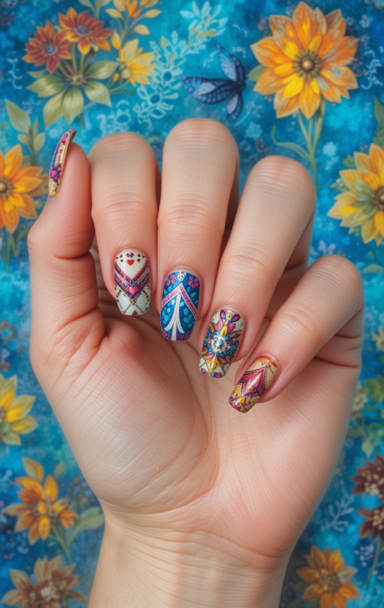Cultural Canvas: Global Traditions Inspiring Modern Nail Art
Introduction
Nail art has evolved from a simple grooming practice to a dynamic form of self-expression and creativity. While modern nail trends often emphasize innovative techniques and bold aesthetics, their roots can be traced back to diverse cultural traditions worldwide. From ancient Chinese dynasties to indigenous body art, cultural motifs have significantly influenced contemporary nail designs. This article explores how global traditions inspire modern nail art, reflecting a fusion of history, culture, and artistic expression.
The Historical Significance of Nail Art
Nail art is not a recent phenomenon; its history dates back thousands of years. Different civilizations have used nails to symbolize status, beauty, and even power.
Ancient Egypt
In ancient Egypt, nail color denoted social status. Egyptian women, including Cleopatra, used henna and natural dyes to tint their nails in shades of red and gold. This tradition continues today in Middle Eastern and South Asian cultures, where henna remains a popular decorative art form for nails.
Chinese Dynasties
During the Ming and Qing dynasties, Chinese aristocrats applied lacquered nail colors made from beeswax, gelatin, and egg whites. Long nails were a symbol of nobility, reflecting a lifestyle free from manual labor. The elegance of intricate Chinese floral and dragon motifs has greatly influenced contemporary Asian-inspired nail art.
Indigenous Nail Art Practices
Indigenous communities worldwide have also contributed to nail art traditions. Many Native American tribes used natural pigments to decorate their nails, symbolizing identity and cultural heritage. Similarly, African tribes utilized elaborate hand and nail painting as part of their ceremonial and spiritual practices.
Global Influences in Modern Nail Art
Today’s nail artists draw inspiration from diverse cultural elements, blending traditional motifs with contemporary aesthetics. Let’s explore some of the global influences shaping modern nail designs.
Japanese Nail Art: The Kawaii and Wabi-Sabi Aesthetic
Japan has significantly influenced the nail industry with two contrasting aesthetics—kawaii and wabi-sabi.
- Kawaii (Cute) Style: Characterized by bright colors, glitter, and adorable 3D embellishments like Hello Kitty and anime figures.
- Wabi-Sabi (Imperfection Aesthetic): Emphasizes natural, uneven textures, inspired by Japanese pottery and Zen philosophy. Minimalist nail designs with subtle gold foiling and earthy tones reflect this concept.
Indian Mehndi and Mandala Designs
Henna art has inspired intricate mandala and paisley designs in nail art. Traditional Indian motifs, such as peacocks, floral patterns, and symmetrical henna-inspired details, are popular in bridal and festival nail designs worldwide.
Mexican Sugar Skulls and Dia de los Muertos Motifs
The vibrant aesthetics of Mexico’s Día de los Muertos (Day of the Dead) have found their way into nail art, featuring sugar skulls, marigold flowers, and intricate skeleton designs. These bold and colorful patterns celebrate life and remembrance, reflecting Mexican heritage in contemporary beauty trends.
African Tribal Patterns
African culture is rich in geometric and tribal patterns, which have influenced nail art through bold lines, dots, and earthy tones. These patterns often take inspiration from traditional textiles such as Kente cloth, Maasai beadwork, and Ndebele wall art.
Korean Glass Nails and Minimalist Chic
South Korea has revolutionized the nail industry with glass nails, inspired by the country’s traditional Hanji paper. This technique creates a holographic effect, resembling shattered glass. Korean beauty also embraces minimalist nail designs with subtle pastels, nude shades, and negative space art.
Russian Folk Art and Matryoshka Dolls
Russian folklore has inspired delicate, hand-painted nail art featuring Matryoshka dolls, floral patterns, and intricate lace details. These elements highlight Russian culture’s artistry and craftsmanship, adding a unique touch to modern nail designs.
Middle Eastern Opulence: Gold Foil and Jewel Embellishments
Middle Eastern beauty traditions emphasize opulence, reflected in nail art through gold foiling, jewel embellishments, and elaborate geometric patterns inspired by Islamic art and Persian carpets.
The Fusion of Tradition and Innovation
Modern nail artists are not just replicating traditional patterns but reinventing them using contemporary materials and techniques. Innovations such as gel nails, holographic powders, and 3D printing allow for intricate cultural designs with a modern twist. Some ways traditional elements are incorporated include:
- Hand-Painted Details: Artists use fine brushes to create intricate cultural motifs.
- Stamping and Decals: Pre-designed cultural patterns applied easily to nails.
- Embossed and Textured Art: Raised designs that mimic fabric patterns and carved wood details.
- Glow-in-the-Dark and Color-Changing Effects: Adding a futuristic touch to traditional motifs.
The Cultural Appreciation vs. Appropriation Debate
While cultural influences enrich the beauty industry, they also raise questions about cultural appropriation. It is essential for nail artists to respect and acknowledge the origins of the designs they incorporate. Collaborating with cultural artists, learning about the significance behind motifs, and crediting traditional sources can ensure that cultural nail art is a form of appreciation rather than exploitation.
Nail art is more than a beauty trend; it is a global canvas that tells stories of history, culture, and artistic expression. The fusion of traditional motifs with modern techniques creates a bridge between the past and the present, celebrating cultural diversity in a visually stunning way. As nail art continues to evolve, it remains a testament to the beauty of cultural exchange and innovation in the world of fashion and beauty.















